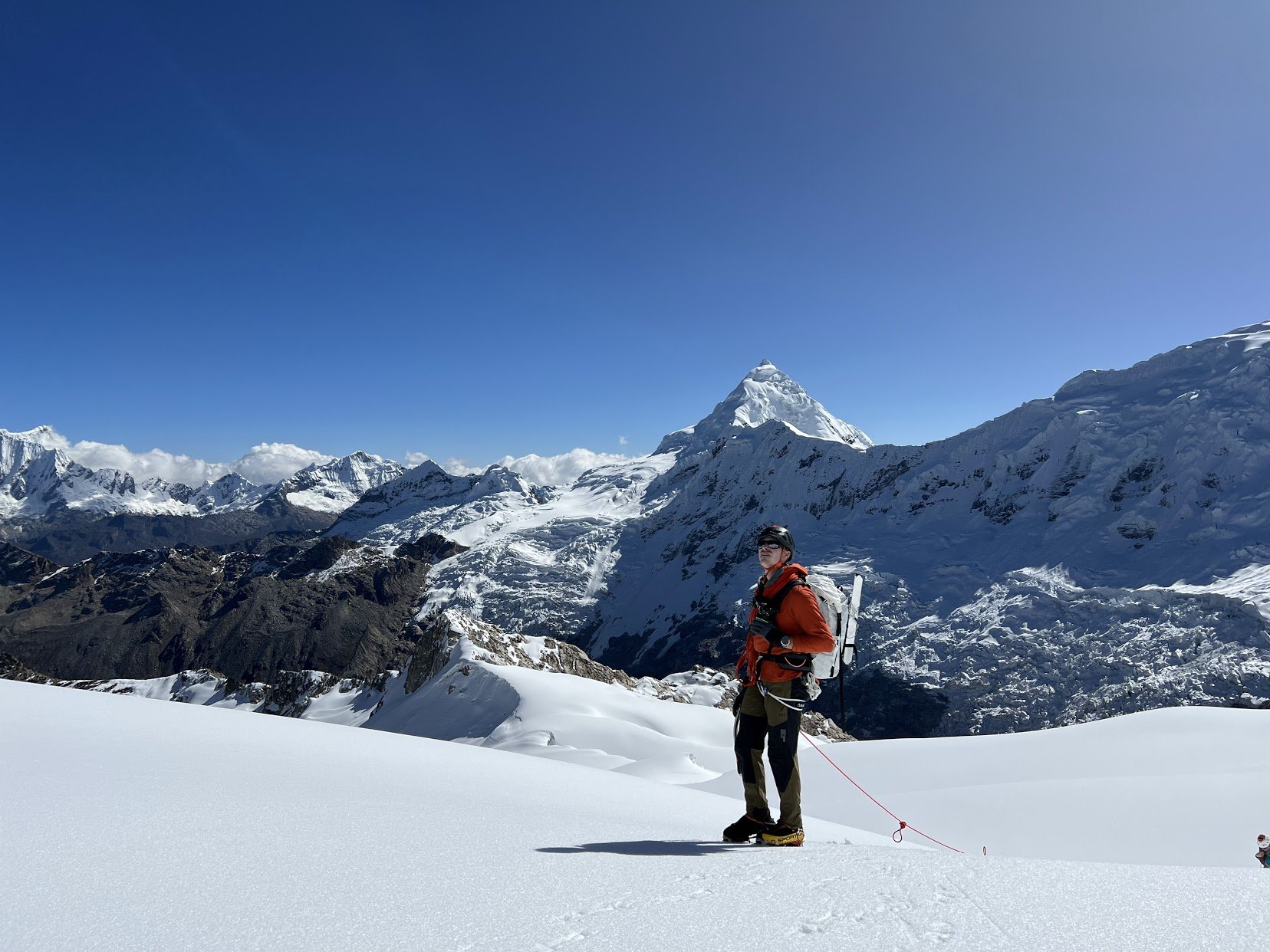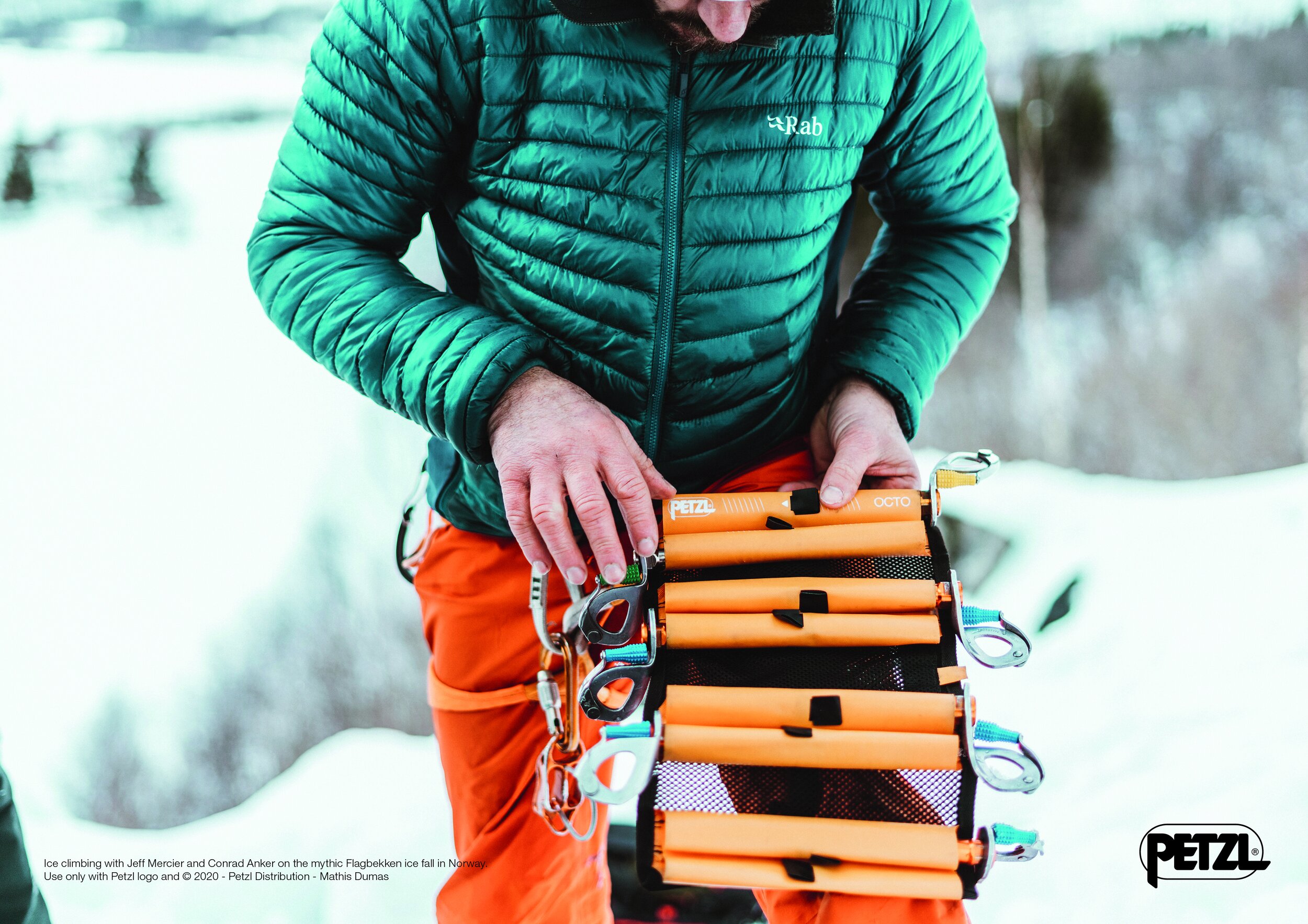
Essential Alpine Climbing Gear Guide
Alpine
Our guide team puts a lot of time into testing and reviewing some of the best gear in the industry. This catalog of our team's alpine climbing gear is broken into categories: Clothing, Gear Essentials, Alpine Specific, and Overnight.
The alpine kit can be very ambiguous because there are many environments where we, as climbers, climb. We focus this kit on mountain ranges such as the Cordillera Blanca, Cascades, Bugaboos, and Chamonix to give a large breath of alpine terrain.
Each link above is a toggle to move you down this page to the style of climbing you would like to review. You will stay on the same page and can scroll up or down to preview other category information at any time.
CLOTHING
FOOTWEAR
Spring Glacier / Rock Boot- La Sportiva Aequilibrium Speed GTX
This is your 3 season alpine boot and most likely your go-to spring alpine boot for most climbs. Seek comfort on the approach, waterproofness for the snow, and rock climbing functionality in more manageable technical climbing sections. Pro-tip: Dot-rubber the front section of the sole for better climbing performance if you are in a lot of technical rock terrain.
Mountain Boot - La Sportiva G-Summit
The G-Summit or comparable style boot from other manufacturers is the boot style of choice for colder weather, alpine conditions, or when climbing more ice on the route and needing a more stable climbing platform for your crampons. The integrated gaiter and slipper sock design provides a high level of waterproofing and increases warmth without sacrificing weight. For these reasons, you will see many experienced climbers and guides in this boot over a more traditional leather boot. We highly recommend paying the additional upfront costs for the integrated gaiter when purchasing boots for the first time; you won’t regret it!
**The Fast and Light - La Sportiva TX4 Mid GTX
When you focus more on rock climbing capabilities in areas like the Bugaboos, where glacier travel is mostly easy and minimal, you can get away with a mid-top approach shoe. You can cut weight on the hike and gain a lot of climbing performance for easier routes like the West Ridge of Pigeon Spire or even the North East Ridge of Bugaboo Spire. It’s an option we use often when we are not working and need to go a little faster and lighter.
High Altitude Boot (Above 5000m)- La Sportiva G2 Evo
Alpine climbing environments change depending on location, and in the high alpine, think South America and 6000m peaks, a warm and light double boot is critical. These routes often necessitate camping/bivying on the glacier. A liner that can be removed is key for drying out the inner boot and ensuring your feet are warm at the start of the day. A single boot will freeze overnight, making them ice cubes in the morning. Liner boots can be stuffed in your sleeping bag overnight, allowing them to dry and be warm in the morning.
Socks - Smartwool Mountaineering Extra Heavy Crew Sock
Wool retains heat when wet, so the heavyweight option will provide the most so the heavyweight option provides the most warmth. As a bonus, you can use these socks when you size your climbing boots at the shop.
UPPER LAYERS
Layer 1- Synthetic Sun Hoodie
Mountain Equipment Women’s Glace Sun Hoody and Men’s Glace Sun Hoody
Sun hoodies have revolutionized layering. They’re lightweight and breathable for the warm approach and protective enough when the weather cools a pre-dawn starts. If you do sweat, bringing two of these layers, one for the approach and one to swap at the base of the climb will offer the option to stay dry, even if working hard on the morning approaches. The hoodie feature also blocks much of the sun's UVA rays, protecting your body from burns, which is critical in snow.
Layer 2- Fleece
Mountain Equipment Women’s Lumiko Grided Fleece Hoody and Men’s Eclipse Grided Fleece Hoody
Grided fleeces are a proven technology. They breathe well and add more warmth than a sunhoody. This piece has a good chest pocket for storing a phone and other small valuables. We interchangeably swap this layer and the sunhoody based on the day's temperature and output. An optional hood may be preferred and should be supplemented as needed.
Layer 2 Addition- Mid Layer Insulation
Mountain Equipment Switch Pro Hybrid Fleece Hoody
An additional synthetic jacket is used as a layering and active climbing piece. The Switch Pro Fleece breathes flawlessly and is essential as a mid-weight layering piece in colder weather. This piece insulates the core, keeps you warmer, and breathes when needed during high-output activities.
Layer 3 or 4- Insulated Vest
Mountain Equipment Women’s Frostline Vest and Men’s Frostline Vest
Vests keep your core insulated and warmer, promoting an overall sense of warmth without adding bulk to the sleeves. We wear vests year-round, typically over our insulation jacket in the cold or over our fleece during cooler weather. Synthetics or down work well for this layer.
Layer 3 or 4- Windshell/Softshell Jacket
Mountain Equipment Women’s Squall Hoody and Men’s Squall Hoody
High wind is often the weather event that makes most climbing uncomfortable, even with sun and mild temperatures. To help block the wind, we prefer a very light and durable layer. This layer can also be the key to keeping you warm when wearing a fleece; there isn’t enough warmth, but adding more insulation is too much.
Layer 5- Hardshell Jacket
Mountain Equipment Women’s Tupilak Gore-Tex Pro Jacket and Men’s Tupilak Gore-Tex Pro Jacket
Hardshell jacket performance has improved tremendously in the past half-decade, providing the best of protection and breathability. For those reasons, more often than not, we keep softshell fabrics at home and bring the hardshell into the mountains. In an alpine environment, we want to blend weight and durability, which seem to be in contrast. These jackets have a good balance of both and won’t fail you.
Layer 6-Cold Weather Insulated Climbing Jacket / Alpine Rock Belay Parka
Mountain Equipment Women’s Oreus Hooded Jacket and Men’s Oreus Hooded Jacket
Our team moves fast in the mountains, which starts with efficiency. In the summer, we carry this layer in our backpack but pull it out when the winds pick up on ridges. In winter, we climb in this layer when the snow and wind are constant. The Oreus line is a warm, lightweight package with a thoughtful design that will make climbing tasks easier in bad weather.
Layer 7- High Altitude Belay Parka
Mountain Equipment Women’s K7 Parka and Men’s K7 Parka
Originally developed as an insulating last line of defense for hard, Alpine-style climbing at altitude, the K7 has seen use on everything from Denali’s ultra-committing hard test piece, the Slovak Direct, to a Piolet d’Or-winning first ascent of Nyainqentanglha’s South East Face in Tibet. It’s quickly become a much more widely used down jacket, a popular choice everywhere from Nepal's 6000m peaks to Aconcagua and Polar regions. The characteristics that see it relied on by those at the leading edge of mountaineering are just as relevant if you’re planning your first more remote expedition.
A large emergency parka is nice, even if it just sits at base camp. Cold mornings and nights can get uncomfortable without a little extra insulation. In the high mountains, we sleep in this layer to help keep our sleeping bags smaller and save weight without sacrificing warmth. And, of course, when the weather is horrible and we still need to climb, we need a storm shelter.
BOTTOM LAYERS
Layer 1- Synthetic Base Layer
Arcteryx Women’s Rho Heavyweight Bottoms and Men’s Eclipse Bottoms
Adding a base layer to your bottom half can keep heat in when it’s cold. This is a classic recommended rock, alpine, ice, and skiing piece.
Layer 1 or 1.5- Synthetic Shorts
Mountain Equipment Women’s Comici Shorts and Men’s Comici Shorts
The following active layer for your lower half offers a nice trekking layer option for the hike into base camp.
Layer 2- Softshell Mountain Pant
Mountain Equipment G2 Mountain Pants
The G2 Mountain Pant collection is currently the standard colder-weather softshell pant for snow/ice/rock environments, and we prefer softshells for this layer because of the additional durability you receive from the fabric. This is your outer layer and will go over the top of your other pieces. These layers move well in the mountains and haven’t let us down yet!
Layer 3- Stormshells
Mountain Equipment Women’s Tupilak Pant and Men’s Tupilak Pant
Active blizzarding? Wet outside? You need a storm shelter to keep you dry. These full-spec mountaineering pants give total protection and mobility in the worst conditions imaginable. Using GORE-TEX Pro 80D fabric throughout, they easily resist abrasion in ice-choked chimneys, and further reinforcement protects against cuts from racked screws. We always pack a hardshell pair of pants in the mountains, even if seldom worn. This layer should fit over all of the above pieces. Full side zips are essential for ease of putting this layer on over all your other layers, including when in boots and on the move.
Layer 4- Insulated Pants
Mountain Equipment Kryos Pant
Originally developed for hard climbing on 7000m peaks, these light and exceptionally weather-resistant down pants are equally at home on minimalist Polar expeditions. WINDSTOPPER® shell fabric resists wind and snow whilst aiding thermal efficiency, and an active cut ensures a full range of movement in hostile conditions.
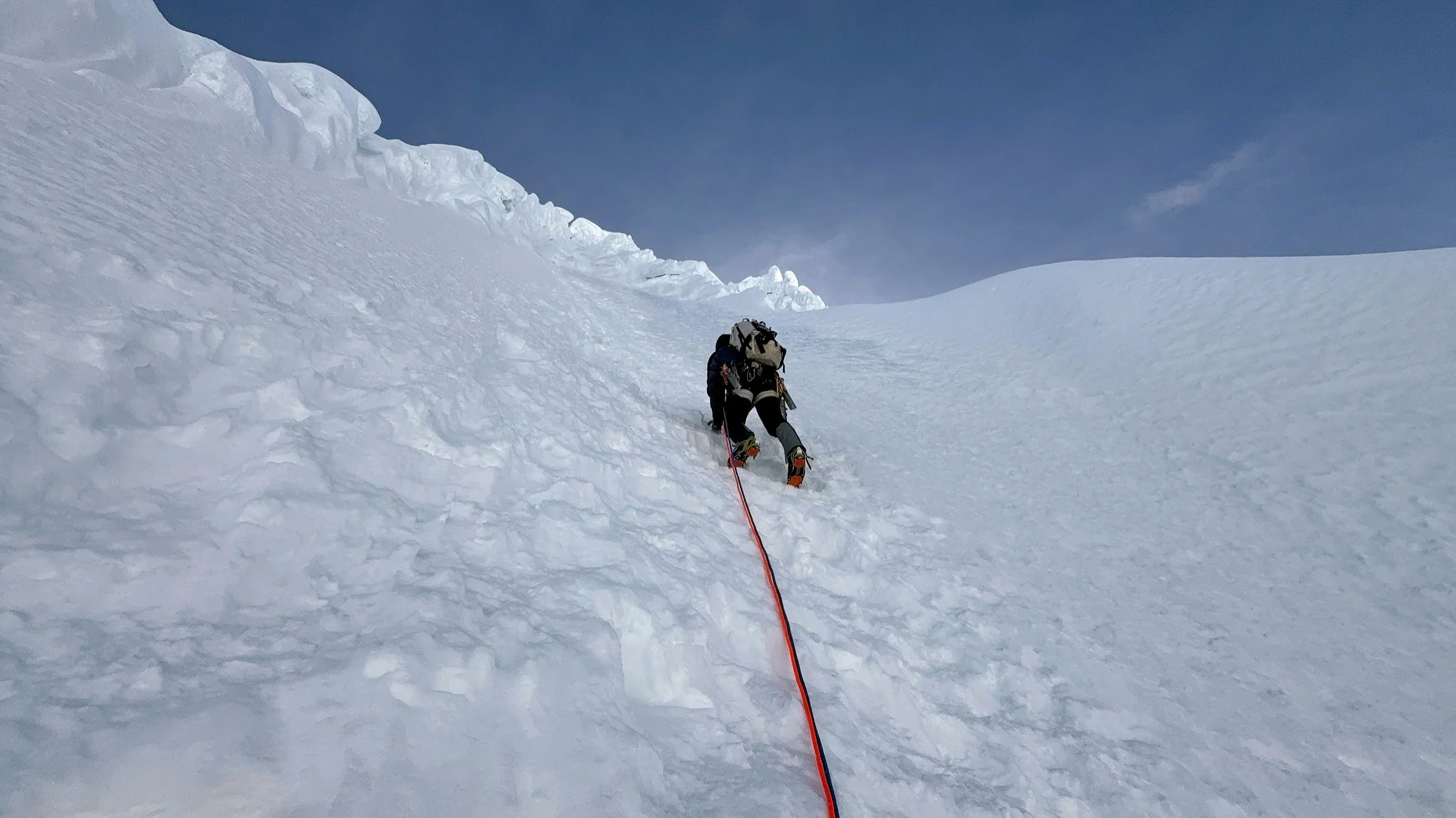
ACCESSORIES
Approach Glove
Mountain Equipment Mugi Grip Fleece Glove
It's great to sweat in and wet out on the approach and then toss them into your bag at the start of the climb.
On Route/Rope Work Climbing Glove
A great all-around climbing glove when it gets colder on the rock, and you need to climb in gloves. They are dexterous and well-built for climbing granite cracks.
Warmer On Route Climbing Glove
Showa TemRes 282
This is a great all-around climbing glove. It is truly waterproof and is ideal when it gets cold, your route has more snow, or the conditions are very wet. However, the gloves run small, so size up one or two sizes…
Colder Weather Climbing/ Belay Glove
High durability, high warmth glove for cold climbing and belaying. We like this glove since it also transfers to a fabulous winter work and ski glove. Versatility counts in your kit!
Emergency Glove/Mitt
Mountain Equipment Redline Mitts
When facing extreme cold, mitts are often the only option for keeping hands warm or rewarming when needed. The Redline is one of the warmest mitts, designed for the harshest sub-zero environments and extended cold weather use. Extensively proven in the world’s highest mountain ranges and on the most serious polar expeditions, the Redline Mitt provides essential protection for mountaineers, climbers, and extreme skiers venturing to the coldest corners of the globe.
Sun Hat
Smile Mountain Guides Happy Camper 5 Panel Hat
Water Bottle
A bladder-style water bottle conserves space as you consume more water, and these are still very durable.
Food: Energy Bars, Fruit, Sandwiches, Trail Mix. 100 Calories an hour!
Sunglasses
Goggles
When there is high wind and extreme cold, you should change from sunglasses to goggles to better protect your face. A bright low-light lens is best for improving visibility in poor conditions.
Sunscreen/ Lip balm
Utu’s Clean SPF50+ Mineral Sunscreen Stick
Look for Zinc products when searching for sun protection. Utu’s stick opt is great for easy application, and they have a low-impact ethos as a company.
Buff
Smile Mountain Guides Neck Gaiters
Buffs are multi-functional, making them great pieces for warmth in colder environments and as sun protection in warmer or sunnier ones.
GEAR ESSENTIALS
Helmet
Both helmets are light and have entire top and side impact ratings. They are also ski-rated, making this ideal if you’re multi-disciplined.
Harness
Having tested many harnesses, the Sitta is a great blend of durability, packability, and versatility. We use this harness year-round, from sport climbing and long trad routes to ice climbing in the winter. If you are looking for a slightly lighter, lower-profile version that sacrifices some comfort, the Whisper is for you!
Climbing Shoes
Picking the right climbing shoes can be very personal; the best shoe is the one that first fits your foot. We encourage you to find a shoe that fits well and is not uncomfortably tight… We use the raves for a lot of our climbing. They are especially adept for alpine rock, where we can slide them on and off with ease and wear a sock with them, and they have great packability.
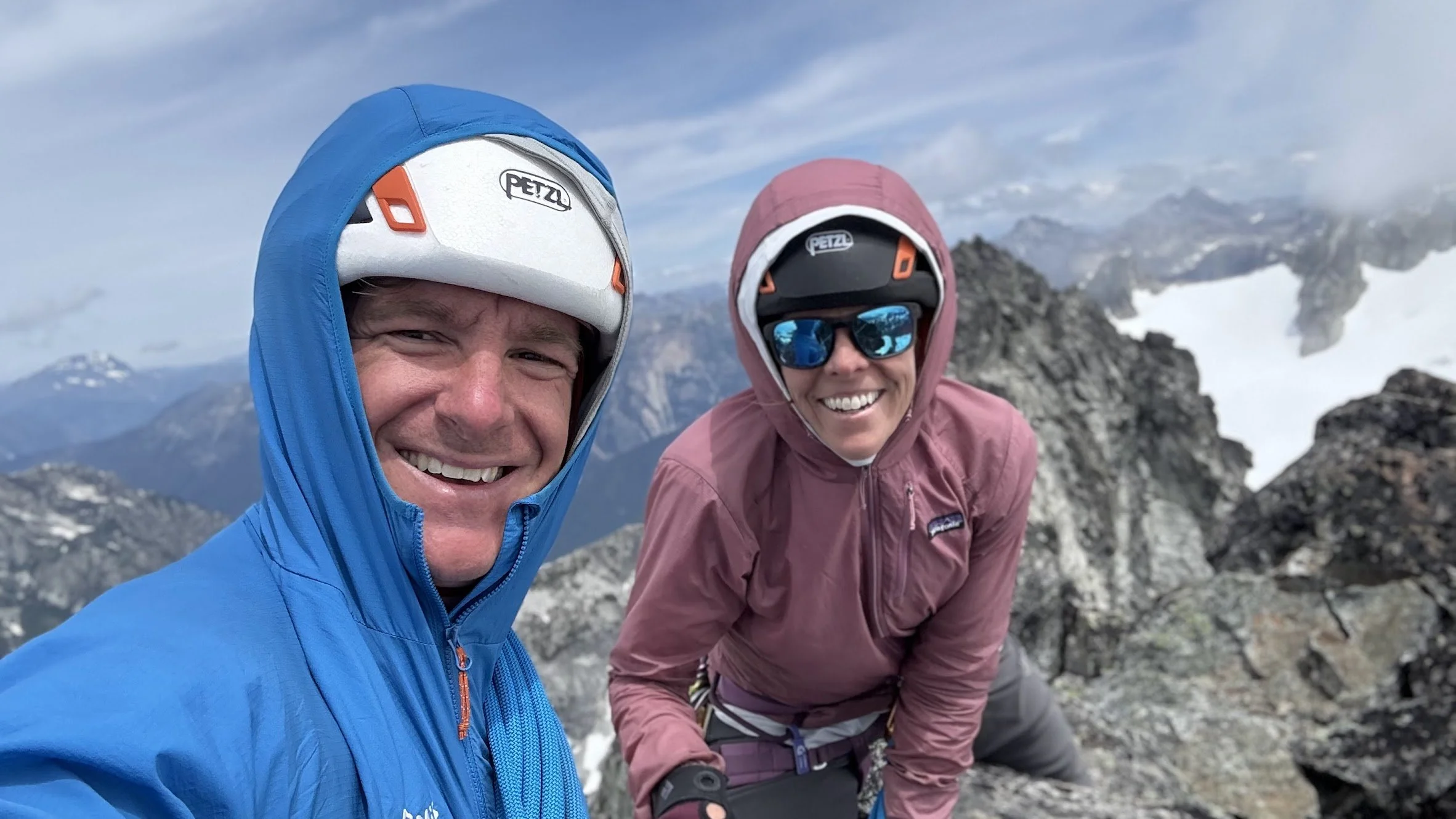
Ropework / Belay Gloves
Gloves are a great tool to increase security and comfort when managing the rope. We belay with gloves all the time outside and sometimes in the gym! They are beneficial for rappelling on longer multi-pitch objectives.
This comprehensive medical kit is supported by the medical director of many guide services, Alan Oram.
Communication Devices
Cell Service - SmartPhone
Having climbing apps on your phone will make this a more versatile tool. Gaia, Mountain Project, and Topo Maps are all great. Download zones before leaving service.
Remote Garmin InReach Mini
This is a reliable backcountry emergency communication device that can be programmed into your phone for easier use in the field. It’s a must-have.
Remote (Multiple Climbing Parties ) - Wouxun Dual Band VHF/UHF 200 Handheld Commercial Radio
These are specific tools for backcountry climbing with multiple parties in an area. You can program channels and communicate easily between groups.
Climbing Backpacks
On Route Climbing Pack
Mountain Equipment Tupilak 30L+
These have proven to be great all-around climbing backpacks with nice, simple features. Try looking for a sleek design that prevents snagging as you climb, providing some versatility for different climbing situations. The Tupilak series has compression straps, which make storing snow pickets easier and more convenient for snow routes. Great for places like the Cascades, where one-day-overnight missions are plenty!
Load Carrying Pack
Mountain Equipment Tupilak 50-75L Ice Pack
We need to consider a load-carrying pack's weight, size, and features. We are looking for a backpack with a simple, discipline-focused design that carries well and still remains lightweight. It’s hard to find a more versatile mountain pack than this one!
Guide Tarp- Function before Fashion, Rab SilTarp 2
The FunctionB4Fashion rescue sled and emergency tarp will help in the worst situations. It is a high-quality and durable option and, at the moment, a better option than others we’ve seen/used in the industry. The Rab Siltarp 2 is a more classic guide tarp that can be used in much the same way as the Fb4F tarp, except for ski-compatible strapping options.
Guidebook - Mountain Project
Alpine Gear Specifics
Dynamic Climbing Rope(s)
1:1 w/ walk-off or 30 m rappels - Petzl Volta Guide 9.0 mm, 60 m
1:1 w/ more than several rappels - x2 Petzl Paso Guides 7.7 mm, 60 m, different colored ropes
Ice Axe - Petzl Sum’tec
A versatile mountain axe that can adopt an adze or hammer depending on the climbing you will be doing. For more rock, take a hammer for pitons. For more snow, take an adze for snow anchors. When using a hammer, use the large Marteau from Petzl. This makes hammer pins much easier.
Technical Ice Tools- Petzl Quarks
Petzl Quarks are a great mountain tool; we have one with a hammer for nailing in pitons and one with an adze for building snow anchors. We remove the Griprest handrest on the tools as they are not needed in this type of environment.
Crampons - Petzl Irvis
A light and versatile 10-point crampon made of steel. Often, we are walking over or climbing on rocks. We find that aluminum crampons do not last. Adapting an aluminum heel piece to a steel front point can reduce weight and maintain a decent level of durability.
Small Assortment of Camalots - Black Diamond Ultralight C4’s
An assortment of rock gear is nice in a varied alpine environment. Supplement more or less gear depending on climbing objectives. We typically bring a single rack of BD C4 .3- #2 for most alpine-styled climbs with mixed conditions. Think West Ridge of Forbidden
Single Stopper Set - Black Diamond Stopper Set Classic #5 - #11
Stoppers are a great piece in the mountains and often hold better in icy cracks than SLCDs. They are also great pieces to have for building anchors on the up or for bailing on the down.
Ice Screws - Petzl Laser Speed Light
A small assortment of 17cm (blues) will get you through most ice sections on an alpine route. If the climbing has more or less ice, adjust. One 21 cm screw length for building threads and for anchoring is still nice to have.
Shoulder Lengths - Petzl Pur’Anneau 60 cm, x1 Petzl ANGE S Carabiner
We use alpine draws because the terrain is highly variable. Bringing 4-7 works for many objectives, but it’s up to you to decide the best number for the chosen climb.
120 cm Sewn Sling - Edelrid Aramid Cord Sling 6 mm
This is an excellent material for building a rappel extension. It’s strong, more abrasion-resistant than nylon or Dyneema, and knots are easy to untie after being weighted.
Plaquette Styled Belay Device - Petzl Reverso
You may want a device that can belay in “guide mode.” This is a great, light option. If you frequently belay from the top, consider having your team carry Kong GiGi, a plaquette-style device that reduces friction, saving your elbows over time.
5 Locking Carabiners - Petzl Attache
5 total as a minimum for rescues.
Anchoring Sewn Sling - Petzl Pur’Anneau 180 cm
Sewn slings have become very popular as anchors because of their reduced bulk and ease of use. We like one on the harness.
Anchoring Cordelette - Sterling 5.4 mm V-TX Cord 18’
Having a slightly longer cord can help build less traditional anchors, connect gear spread further apart, and sling natural features to incorporate those in a multi-point anchor.
Autoblock Cord - Sterling 6mm Auto Block Cord
Useful friction hitch material for rappels and rescues.Pitons - Petzl Pitons
Semi-hardened steel conforms to cracks and is often used in a limestone setting. Hardened steel works well in strong rock, like granite, and can drive into small cracks. An assortment of sizes is nice. It is used mainly for descent and bailing.
V-Thread Tool - Petzl Multihook and/or Jsnare
A light v-thread tool for building rappel anchors. When using the Multihook, tie a shock cord loop to the eyelet. When donning the Multihook in your 21cm screw, place the shock cord over the ice screw hanger for a more secure carrying method.
Rappel Ring or Quicklink - Petzl GO 8 mm Quicklink
If you need to bail, having a ring or link to rappel off is nice. For a fast and light option, you can configure a system using a non-locking carabiner closed through an overhand on a bight.
Knife - Petzl Spatha
This is a useful part of your bail kit for cleaning tatted anchors and rappel stations and for cutting new material to build better anchors at the stations as mentioned earlier.
Headlamp - Petzl Swift RL
Essential for early morning navigation to the base of longer climbs and a backup/ security piece when night falls and the team is still on route or descending back to the trailhead.
Overnights
Single Wall Tent- Black Diamond First Light ( Tight Two Person ) HiLight ( Slightly More Durable) Eldorado Tent ( Most Durable)
Lightweight Bibler-style tents have been used in the mountains for decades. Well-tested and packable, it is the go-to for full shelter protection on alpine missions!
Rain Tarp- Rab Siltarp 2
Bibler-style tents have a single wall construction, and because of this, condensation build-up is common, especially in wet/humid environments, such as the Pacific Northwest. This tarp has many functions, it can be tension over top of the single wall tents to create an extra barrier of weather protection or make a large camp vestibule. This classic lightweight system will make camping in the mountains very comfortable!
Bivy Bag- Alpine Bivy
If you want to lose weight, the bivy bag is still one of the best options. It is often used in drier climbing areas and on sleeping sites comprised of rock or dirt. However, it is not recommended for humid climates.
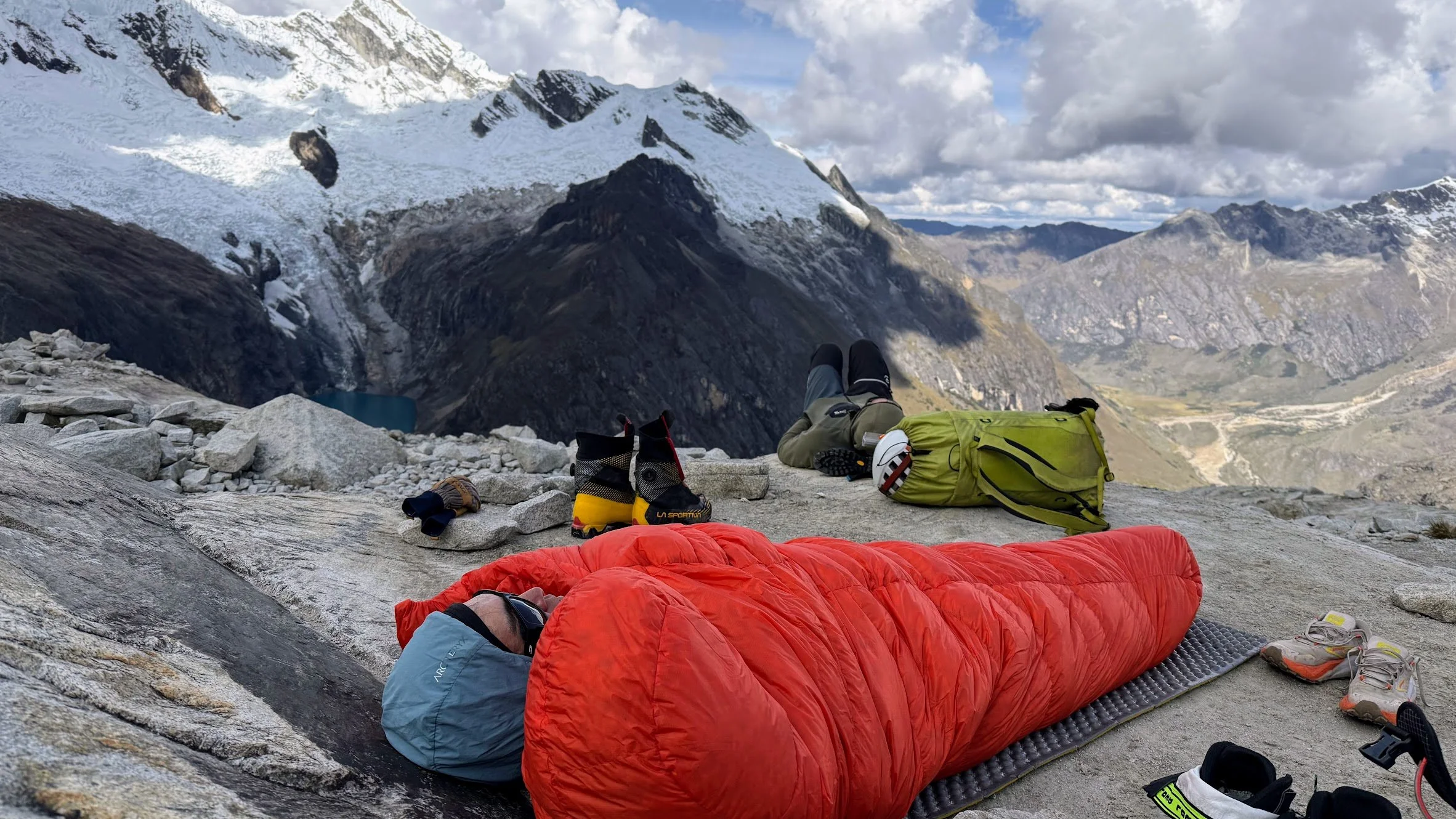
Cooking System- MSR Stove Systems
MSR products are a gold standard for stove systems for backcountry use. The MSR Reactor Stove is one of the fastest-to-boil options on the market with a built-in wind burner. This is ideal for overnight missions or up-and-over bivy climbs, where melting snow and boiling water are your primary goal. Using a 1 L kit with a small gas bottle will provide enough fuel for a 1-day overnight mission. Adjust fuel for the length of the trip. MSR also makes a hanging stove system, which we find very valuable when cooking in tents. (Yes, this happens… keep the vents open)
If going on a more extended trip, and even more so for international expeditions, the MSR XGK-EX stove is the pinnacle. Liquid fuel stoves are easier to maintain or fix in the field, are easier to manage fuel needs, and can be linked to having more burning power at higher altitudes. This stove can quickly and efficiently burn different types of fuels from all over the world.
If you are on a more extended trip, are “slightly” less concerned with output at super high altitudes, and would like better control for cooking, the MSR WhisperLite Universal Stove is a great


